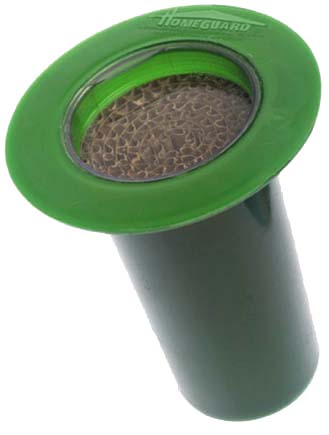| Termite Monitor Comparison |
|
HomeGuard™ |
Other Monitors |
|
Speed of
"hits" |
The HomeGuard™ monitor produces an exaggerated "thermal shadow" which attracts termites to the station. The average number of days from installation to a "hit" is 21 days. No other available monitor works consistently this quick. |
Other monitors rely on random foraging–termites find stations by accident. Extended time is often necessary for this to occur. In some cases "hits" have not occurred even after several years. |
Termite mass
and activity distribution |
The HomeGuard™ monitor attracts large numbers of termites. They not only feed on the matrix, but nest in it. It is common to find thousands of termites in a newly hit HomeGuard™ monitor. When the monitor is replaced with a baited unit the termites remain until mortality occurs. |
Most currently available monitoring systems are a tube within a tube design. Once a hit occurs, the monitor is removed and a bait tube is inserted. This disruption often causes termites to leave the station, sometimes permanently, most likely due to a small number of termites resulting in a weak pheromone trail. |
Contamination
by pesticides
and non-target
organisms |
The HomeGuard™ monitor is designed and constructed with solid walls that help prevent entry of surface applied pesticides and other non-target species that are detrimental to the success of the monitors (i.e. carpenter ants, fire ants, etc.) and chlorinated water from sprinklers. |
Other monitors are plagued by contamination of pesticides and non-target organisms due to inherent design flaws. This causes termites to repel from stations, which may lead to the false conclusion that the colony has been eliminated. |
Ease of
inspection |
Semi-transparent lid eliminates the need to remove for inspection. Our exclusive Frictionally Engaged Lid allows for quick removal when necessary, without the need for clumsy "keys" or special tools. Traps can be successfully inspected in mere seconds. This means much less time is required to inspect and maintain. |
Other monitors require disassembly using cumbersome and special devices for inspection which increases time and associated costs. |
Field life
of matrix |
The HomeGuard™ monitor uses a high-volume corrugated cellulose matrix which remains attractive to termites for extended periods. Because the solid walls prevent ground water from entering and damaging the matrix, HomeGuard™ monitors often remain effective for years. |
Most matrixes are small sticks of wood. Over time the wood decays to the point that it is unacceptable to termites. Some monitors require frequent replacements, increasing operational costs. |


